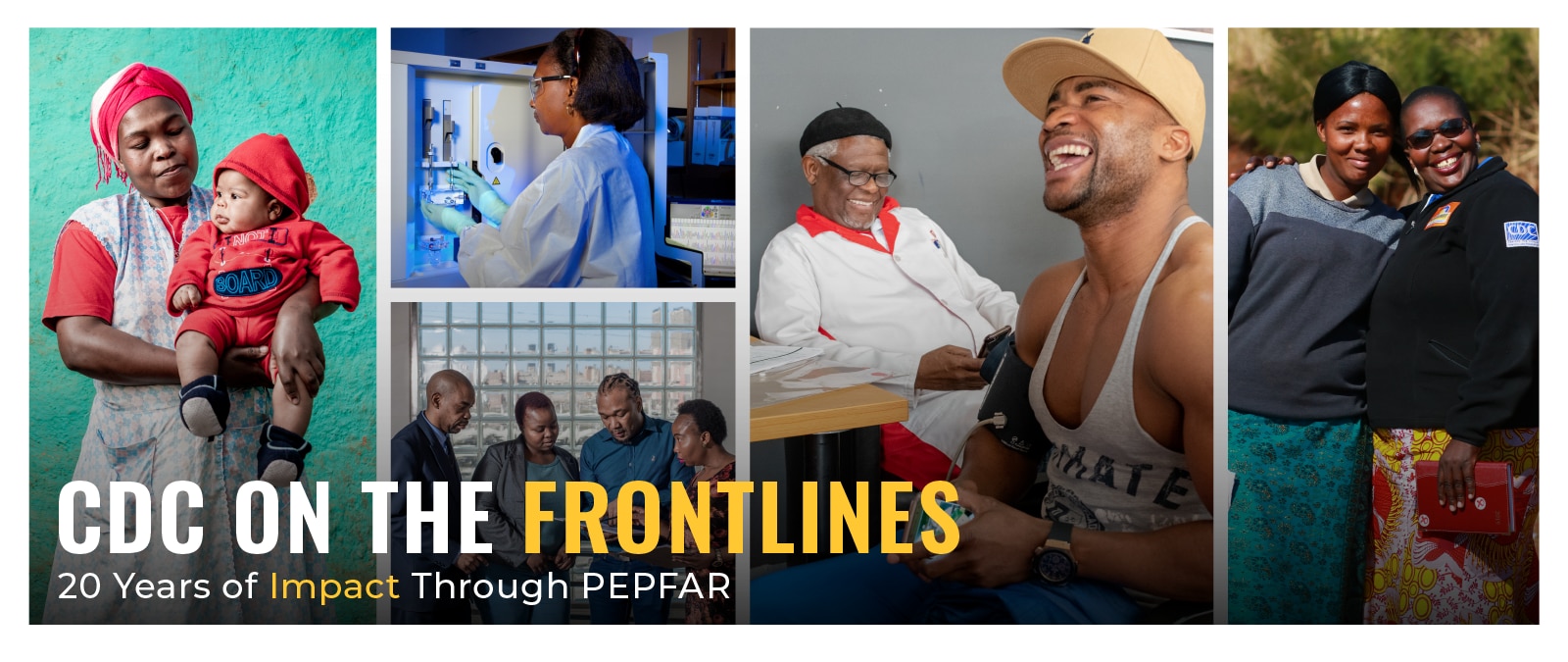
Over the past 20 years, the U.S. President’s Emergency Plan for AIDS Relief (PEPFAR) has saved millions of lives as a leader in the global response to two of the world’s deadliest infectious diseases – HIV and TB. As a key implementing agency of the U.S. President’s Emergency Plan for AIDS Relief (PEPFAR), CDC is at the forefront of these global efforts to treat and prevent these diseases.
CDC plays a unique role, bringing four decades of experience, scientific know-how and on-the-ground expertise to bring about significant impact in the fight against these diseases. Just last year, our efforts accounted for more than 50 percent of all key* PEPFAR outcomes to treat and prevent HIV and TB.

Antiretroviral Treatment for Men, Women, and Children**
PEPFAR: 20.2 Million
CDC: 12.5 Million

Voluntary Medical Male Circumcisions (VMMC)****
PEPFAR: 30.1 Million
CDC: 15.5 Million

People Who Received a Positive HIV Test Result***
PEPFAR: 2.2 Million
CDC: 1.4 Million

HIV-Positive Persons Screened in Care for Tuberculosis***
PEPFAR: 16.8 Million
CDC: 10.2 Million

Antiretroviral Treatment to Prevent Mother-to-child Transmission***
PEPFAR: 737,000
CDC: 484,000
Sources: Cumulative U.S. President’s Emergency Plan for AIDS Relief (PEPFAR) MER Results
*Those interventions known to have the greatest impact on reducing new annual HIV infections and deaths.
Note: Other USG agencies may have also contributed to some of these achievements **As of Sept 30, 2022 ***FY2022 ****Cumulative through Sept 30, 2022
CDC and photo documentarian Thom Pierce traveled to the epicenter of the global HIV epidemic in South Africa to capture the faces and stories of the individuals at the forefront of CDC’s global response against this epidemic.
These are their stories...

"Sometimes I think God brought me back from the grave, so I can help the people to live!"
Photo Left: When Thembi tested positive for HIV nearly 20 years ago, she became so ill she almost died. Today, thanks to HIV treatment she received through CDC-supported services in Eswatini, she is healthy with no detectable trace of the virus in her body. She is now a peer educator and is the mother to 10-year-old History who is HIV-free. Photo by: Brittany K. Moore 2019

CDC is at the forefront of efforts to get life-saving treatment to millions of people living with HIV around the world. In 2022, as a part of PEPFAR, CDC supported antiretroviral treatment for 12.5 million people living with HIV – more than 40 % of all people on HIV treatment worldwide.

“I’m glad I decided to do it. I feel like I’m doing something positive for my health. It’s the best decision I could’ve made!”
Photo Right: Thirty-year-old Jason arrives at the Winnie Mandela Male Sexual Health Clinic in Tembisa where he will speak with a counselor before undergoing voluntary medical circumcision to protect himself from HIV. Photo by: Thom Pierce 2018

VMMC has been shown to reduce a man’s risk of acquiring HIV by up to 60 percent. To date, as of September 30, 2022, CDC has supported VMMC procedures for 15.5 million men in Southern and Eastern Africa – just over half (52%) of all VMMC procedures supported by PEPFAR.

“You cannot put somebody on treatment if you don’t know their status – it starts with the lab and it ends with the lab.”
Photo Left: Dr. Karidia Diallo has been part of the CDC’s efforts to transform laboratories through PEPFAR since its inception. Among other key lab advances, she’s witnessed significant innovations in HIV diagnostics, including rapid, index and self-testing, and cutting-edge advances like recency testing. Led by CDC’s experts, these efforts are helping to identify more people living with HIV and link them to lifesaving treatment. Photo by: Thom Pierce 2018

Helping people with HIV know their status and start immediately on treatment allows them to live longer, healthier lives and interrupts the spread of HIV. In 2022, CDC helped 1.4 million people learn their HIV-positive status, more than 60 % (61%) of all new HIV diagnoses identified through PEPFAR.

"We’re not just talking about HIV and TB integration; we’re actually making it happen!"
Photo Right: CDC and partners are transforming the way health facilities are fighting HIV and TB in tandem. Photo by: Thom Pierce 2018

TB is the top killer worldwide of people living with HIV, whose weakened immune systems make them highly susceptible to becoming ill with TB. As of September 30, 2022, CDC supported TB screenings for 10.2 million people living with HIV – more than 60 % (61%) of all people with HIV screened for TB through PEPFAR.

“I’m still alive. And I’ve got this little one who’s beautiful and I love him so much.”
Photo Left: As a result of receiving HIV counseling and treatment at a CDC-supported clinic, today Thobile is leading a healthy life and her baby is HIV-free. Photo by: Thom Pierce 2018

Increasing the number of pregnant women on life-saving HIV treatment, helps mothers live longer, healthier lives and helps eliminate new infections among children. In 2022, CDC supported treatment for 484,000 HIV-positive, pregnant women to reduce the risk of mother-to-child transmission – more than 60 % (66%) of all pregnant women who received HIV treatment through PEPFAR.
Visit our “Faces from the Frontlines” gallery and view this mini-film to learn more about those at the forefront of CDC’s global response to HIV and TB. Highlighting their innovations and tireless efforts, these images and stories offer a snapshot into the work CDC and PEPFAR are leading around the world.
Since 2003, CDC and other PEPFAR implementing partners have helped save more than 25 million lives. These latest data show we are on the path to achieving PEPFAR’s goals of eliminating HIV as a global health threat and validate that PEPFAR and CDC’s efforts over the past two decades are working. While we’ve made tremendous progress, we cannot stop now. We must continue to build on this momentum if we are to end HIV once and for all.